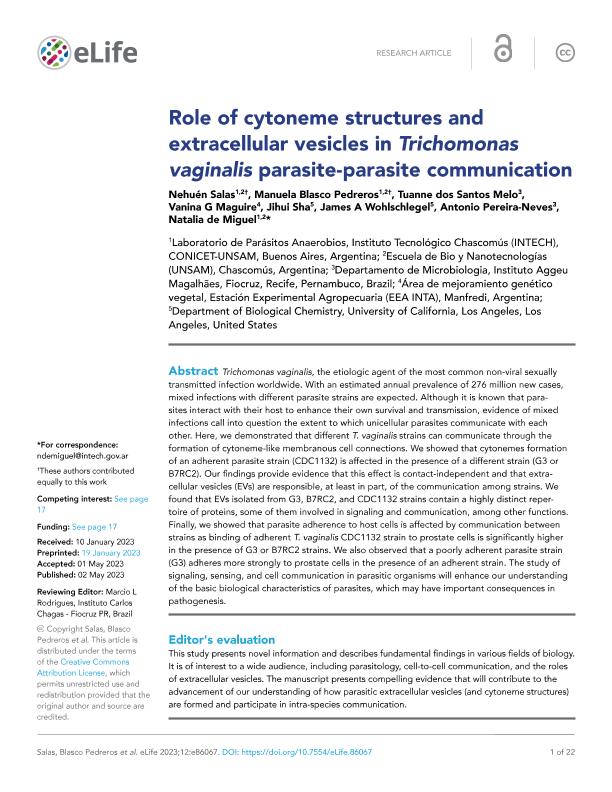Artículo
Role of cytoneme structures and extracellular vesicles in Trichomonas vaginalis parasite: Parasite communication
Salas, Nehuen ; Blasco Pedreros, Manuela Pia
; Blasco Pedreros, Manuela Pia ; dos Santos Melo, Tuanne; Maguire, Vanina Giselle
; dos Santos Melo, Tuanne; Maguire, Vanina Giselle ; Sha, Jihui; Wohlschlegel, James A.; Pereira Neves, Antonio; de Miguel, Natalia
; Sha, Jihui; Wohlschlegel, James A.; Pereira Neves, Antonio; de Miguel, Natalia
 ; Blasco Pedreros, Manuela Pia
; Blasco Pedreros, Manuela Pia ; dos Santos Melo, Tuanne; Maguire, Vanina Giselle
; dos Santos Melo, Tuanne; Maguire, Vanina Giselle ; Sha, Jihui; Wohlschlegel, James A.; Pereira Neves, Antonio; de Miguel, Natalia
; Sha, Jihui; Wohlschlegel, James A.; Pereira Neves, Antonio; de Miguel, Natalia
Fecha de publicación:
05/2023
Editorial:
eLife Sciences Publications
Revista:
eLife
ISSN:
2050-084X
Idioma:
Inglés
Tipo de recurso:
Artículo publicado
Clasificación temática:
Resumen
Trichomonas vaginalis, the etiologic agent of the most common non-viral sexually transmitted infection worldwide, colonizes the human urogenital tract where it remains extracellular and adheres to epithelial cells. With an estimated annual prevalence of 276 million new cases, mixed infections with different parasite strains are expected. Although it is considered as obvious that parasites interact with their host to enhance their own survival and transmission, evidence of mixed infections call into question the extent to which unicellular parasites communicate with each other. Here, we demonstrated that different T. vaginalis strains can communicate through the formation of cytoneme-like membranous cell connections. We showed that T. vaginalis adherent strains form abundant membrane protrusions and cytonemes formation of an adherent parasite strain (CDC1132) is affected in the presence of a different strain (G3 or B7RC2). Using cell culture inserts assays, we demonstrated that the effect in cytoneme formation is contact-independent and that extracellular vesicles (EVs) are responsible, at least in part, of the communication among strains. We found that EVs isolated from G3, B7RC2, and CDC1132 strains contain a highly distinct repertoire of proteins, some of them involved in signaling and communication, among other functions. Finally, we showed that parasite adherence to host cells is affected by this communication between strains as binding of adherent T. vaginalis CDC1132 strain to prostate cells is significantly higher in the presence of G3 or B7RC2 strains. Demonstrating that interaction of isolates with distinct phenotypic characteristics may have significant clinical repercussions, we also observed that a poorly adherent parasite strain (G3) adheres more strongly to prostate cells in the presence of an adherent strain. The study of signaling, sensing, and cell communication in parasitic organisms will surely enhance our understanding of the basic biological characteristics of parasites, which may have important consequences in pathogenesis.
Palabras clave:
PARASITE
,
COMMUNICATION
,
VESICLES
,
TRICHOMONAS
,
FILOPODIA
,
PATHOGENESIS
Archivos asociados
Licencia
Identificadores
Colecciones
Articulos(CCT - LA PLATA)
Articulos de CTRO.CIENTIFICO TECNOL.CONICET - LA PLATA
Articulos de CTRO.CIENTIFICO TECNOL.CONICET - LA PLATA
Articulos(IIB-INTECH)
Articulos de INST.DE INVEST.BIOTECNOLOGICAS - INSTITUTO TECNOLOGICO CHASCOMUS
Articulos de INST.DE INVEST.BIOTECNOLOGICAS - INSTITUTO TECNOLOGICO CHASCOMUS
Citación
Salas, Nehuen; Blasco Pedreros, Manuela Pia; dos Santos Melo, Tuanne; Maguire, Vanina Giselle; Sha, Jihui; et al.; Role of cytoneme structures and extracellular vesicles in Trichomonas vaginalis parasite: Parasite communication; eLife Sciences Publications; eLife; 12; 5-2023; 1-22
Compartir
Altmétricas



